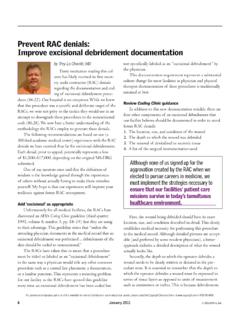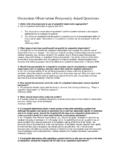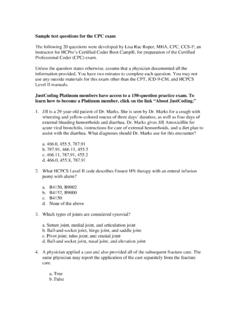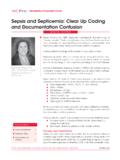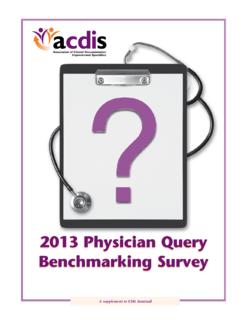Transcription of Criteria-based core privileging: A better way to …
1 Chapter 3. Criteria-based core privileging : a better way to privilege Although credentialing and privileging are related and many people use the term credentialing to include privileging activities, the two processes are distinct. As stated in rule #4 in the Rules of Credentialing . (see Chapter 1), a hospital can grant a practitioner medical staff membership, but not grant him or her clinical privileges. privileging , in particular, presents one of the biggest challenges for medical staff leaders. With today's con- stantly evolving medical technology, the proliferation of new subspecialty areas in medicine, and increased crossover among specialties in performing certain procedures, the task of delineating clinical privileges can be complex and demanding.
2 Approaches to privileging Over the years, healthcare organizations have taken various approaches to privileging , the most common being: Laundry lists . Categorization The descriptive approach Combinations of the above three approaches Delineation by codes Because there are many problems associated with each of these approaches, this book recommends using the Criteria-based core privileging approach, described later in this chapter. But first, we'll discuss the other options. Laundry lists Laundry lists, sometimes referred to as privilege lists or privilege cards, are detailed checklists that itemize the procedures/conditions that applicants can specifically request to perform/treat.
3 Hospitals often use such lists for surgical specialties. See Figure for a sample laundry list. core Privileges for Physicians, Fourth Edition 15. Chapter 3. Figure Sample delineation by laundry list' approach: An excerpt from a department of radiology request form Please check appropriate areas: Admitting privileges General diagnostic radiology Computerized tomography Ultrasonography Magnetic resonance imaging Nuclear medicine Special procedures Arteriography Angioplasty, balloon Angioplasty, laser Intravascular embolization Venography Lymphangiography Lumbar puncture and myelography (lumbar or C1-2 puncture). Percutaneous transhepatic cholangiography and biliary drainage Percutaneous cholecystostomy/bile duct stone removal Percutaneous nephrostomy/stone extraction Percutaneous drainage of fluid collections Percutaneous biopsies Vena cava filter insertion Percutaneous gastrostomy 16 core Privileges for Physicians, Fourth Edition Criteria-based core privileging : a better way to privilege For years, hospitals throughout the United States have delineated clinical privileges using laundry lists or modified laundry lists.
4 The American College of Surgeons recommended the laundry list system in the 1950s because many physicians throughout the country had not completed approved residency programs in specific specialty areas. Many were general practitioners or physicians trained on the job after they com- pleted medical school. The laundry list system has remained in use to the present time. Only within the past decade have medical staffs begun to reassess the usefulness of these long, unwieldy lists of proce- dures or conditions. Today, nearly all physicians who apply for appointment and clinical privileges have completed an approved medical training program in one of the 24 American Board of Medical Specialties approved specialties or more than 60 subspecialty areas.
5 Therefore, the original rationale for using laundry lists no longer applies. The Joint Commission has in- dicated that the delineation of clinical privileges need not be so exhaustive, but laundry lists remain a common approach to the delineation of privileges in hospitals. Despite their popularity, laundry lists have numerous shortcomings: Laundry lists are usually not associated with predefined criteria . When practitioners apply for priv- ileges, they simply check off the procedures they would like to perform or the conditions they would like to treat. Typically, the hospital and its medical staff have not defined the criteria that must be met for each requested privilege (there may be criteria for some but not all privileges) even though both The Joint Commission and the Centers for Medicare & Medicaid Services require Criteria-based privi- leging.
6 (See Chapter 2 for more information about requirements related to Criteria-based privileging .). When using laundry lists, applicants are not routinely required to provide specific documentation of training and experience to show that they are qualified for all requested privileges. Practitioners have been known to apply for all privileges listed because they did not want to take the time to request each procedure or condition. In addition, this approach requires highly trained practitioners to place check marks next to the most mundane clinical conditions or procedures for which they have been thoroughly trained and for which their qualifications are unquestioned.
7 Laundry lists are most often procedurally focused. A laundry list commonly includes those proce- dures that a practitioner might want to perform, but often the cognitive areas of practice are not ad- dressed. Laundry lists are often not inclusive. Because of this drawback, many organizations are tempted to write other at the bottom of the request form, which enables practitioners to request to perform procedures or treat conditions for which the hospital has no predefined privileging criteria or that are core Privileges for Physicians, Fourth Edition 17. Chapter 3. outside the scope of services of the hospital. As stated in rule #2 in the Rules of Credentialing (see Chapter 1), a practitioner who is denied a privilege might be entitled to a fair hearing a traumatic, time-consuming process and, in most cases, the hospital must report the denial to the National Practitioner Data Bank (NPDB).
8 The legal issues associated with laundry lists are complex. Can an organization demonstrate that it critically reviewed a practitioner's request when the request was one of 60 or 80 check marks on a form? If a practitioner fails to check a particular procedure on the list and performs that procedure anyway, is the organization liable for a charge of corporate negligence? Did the organization review the applicant's prior education, training, and experience for each privilege requested? These are all legal issues that are open for interpretation when using a laundry list privileging method. Maintaining laundry lists is an extreme administrative and clinical nightmare.
9 New procedures or new conditions are identified, thus requiring that organizations update and maintain these laundry lists on an almost continuous basis. Categorization Categorization, sometimes referred to as categories or levels of privileges, identifies major treatment areas or pro- cedures that are classified based on the degree of complexity of the procedure or illness to be treated. Typically, categories are based on the level of a practitioner's training and experience. Categorization is widely used to delineate privileges in internal or family medicine because this approach seems to be more applicable to medical ( , cognitive) areas than to surgical ( , procedural) areas.
10 See Figure for an example of categorization. 18 core Privileges for Physicians, Fourth Edition Criteria-based core privileging : a better way to privilege Figure Sample delineation by category approach: An excerpt from an obstetrics and gynecology request form Recommended by Requested Privileges Department Chair Procedures Yes No Yes No Class I Privileges Qualifications: Satisfactory training, current experience, and demonstrated competence in the specific privileges being requested. 1. Diagnostic D&C ____ ____ ____ ____. 2. I&D of Bartholin cyst or perineal abscess ____ ____ ____ ____. 3. Cervical biopsy (not with colposcope) ____ ____ ____ ____.
